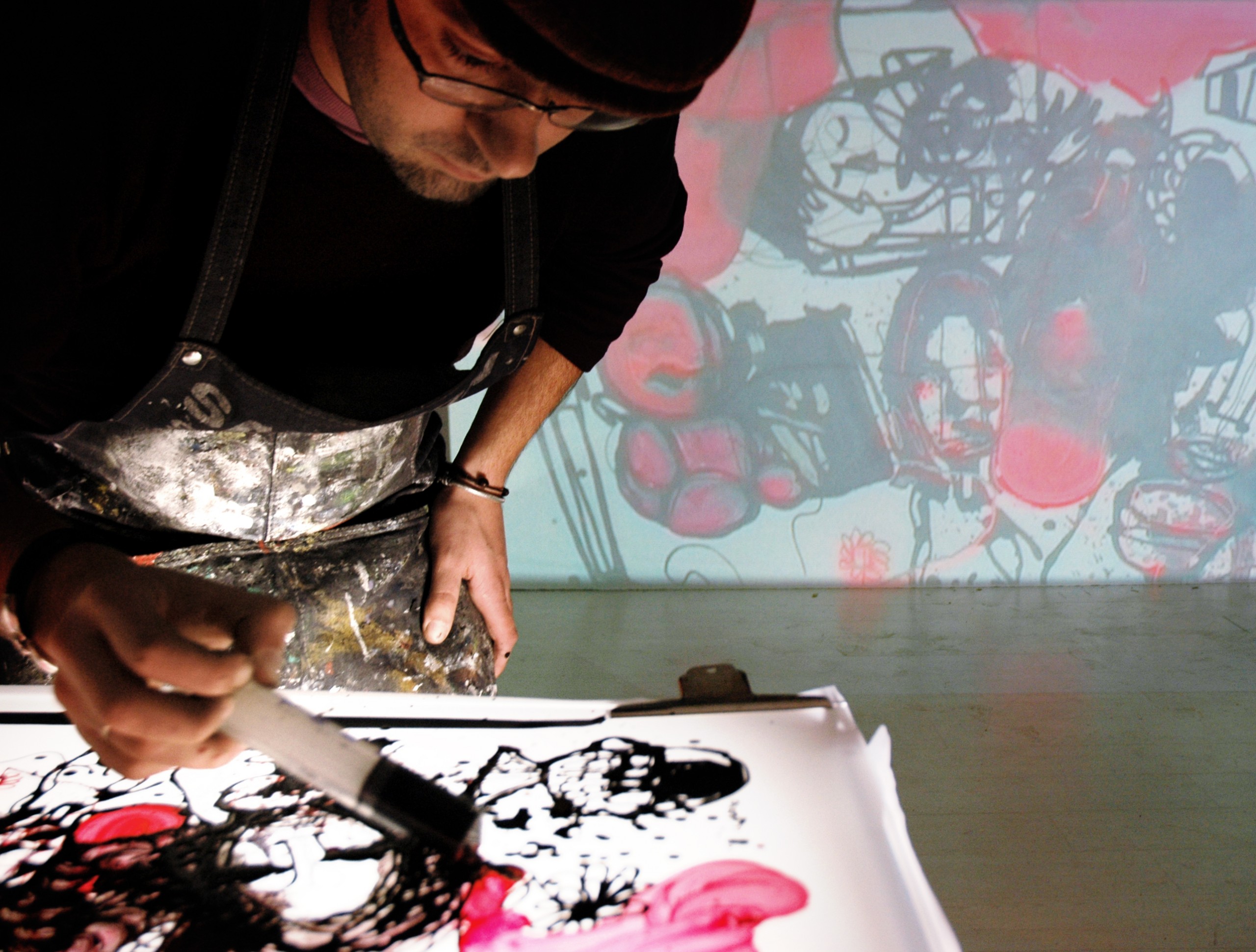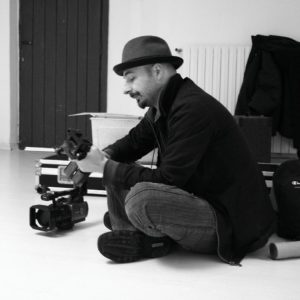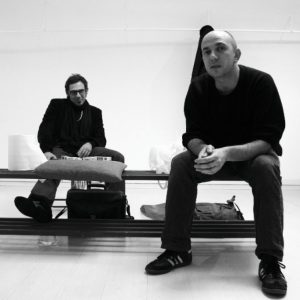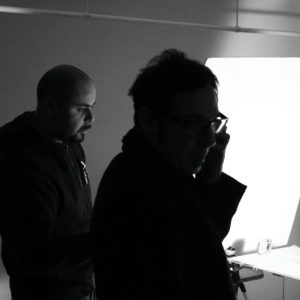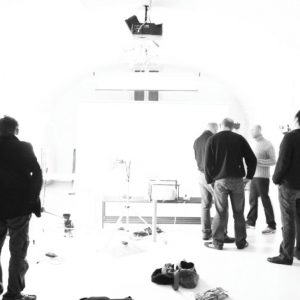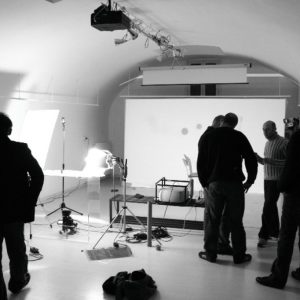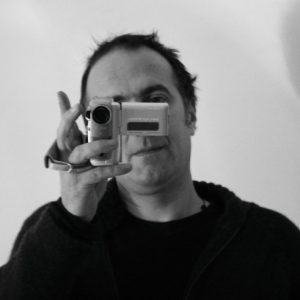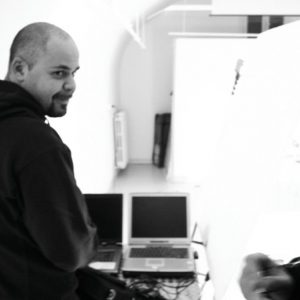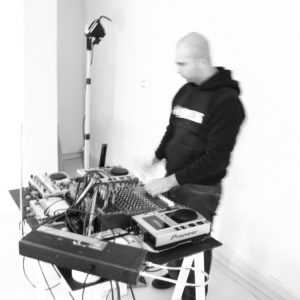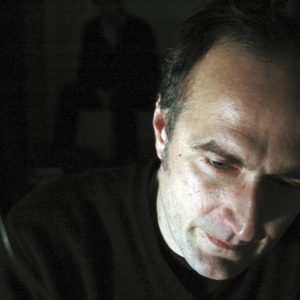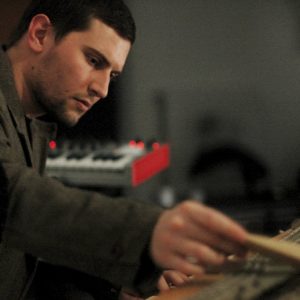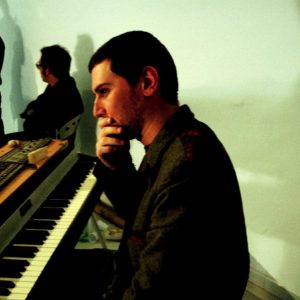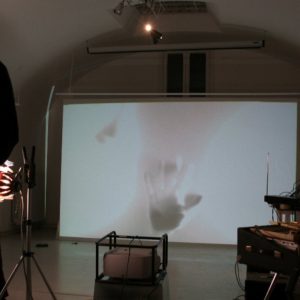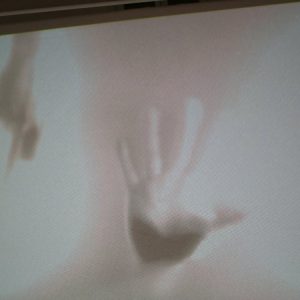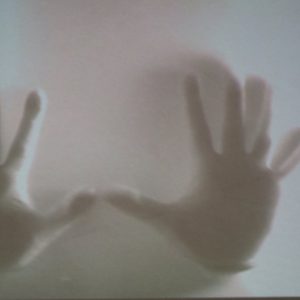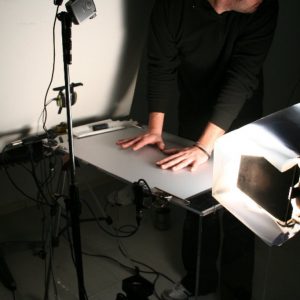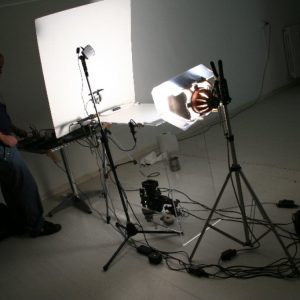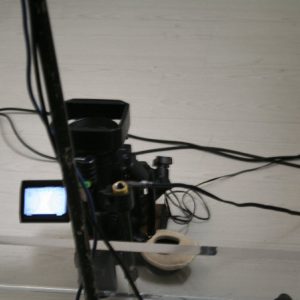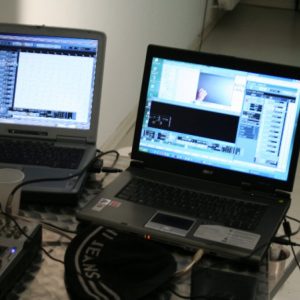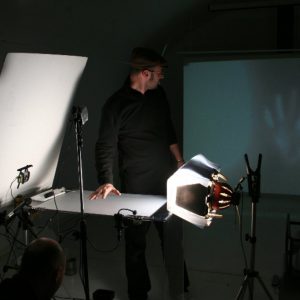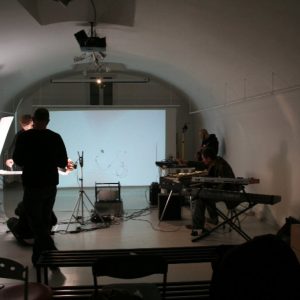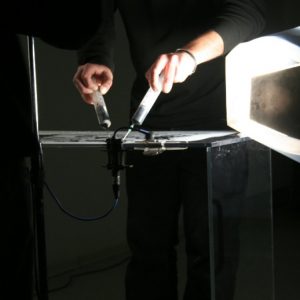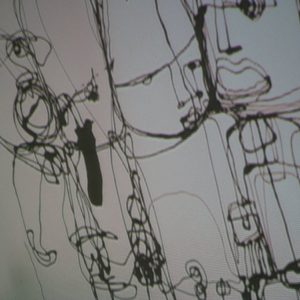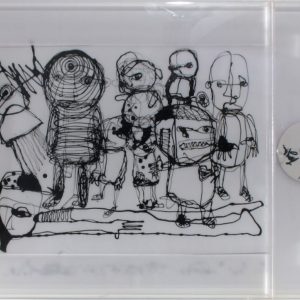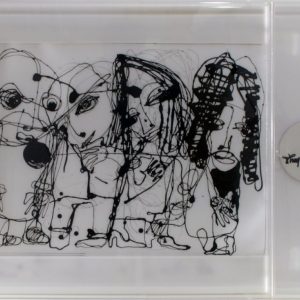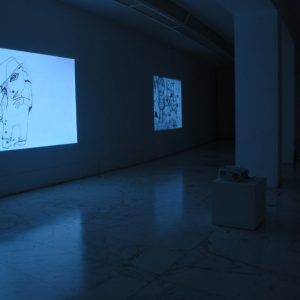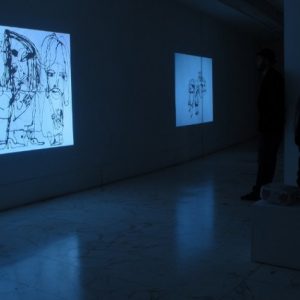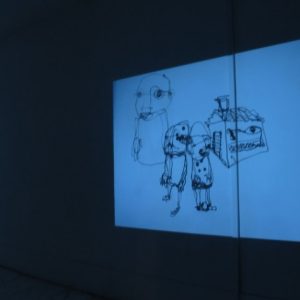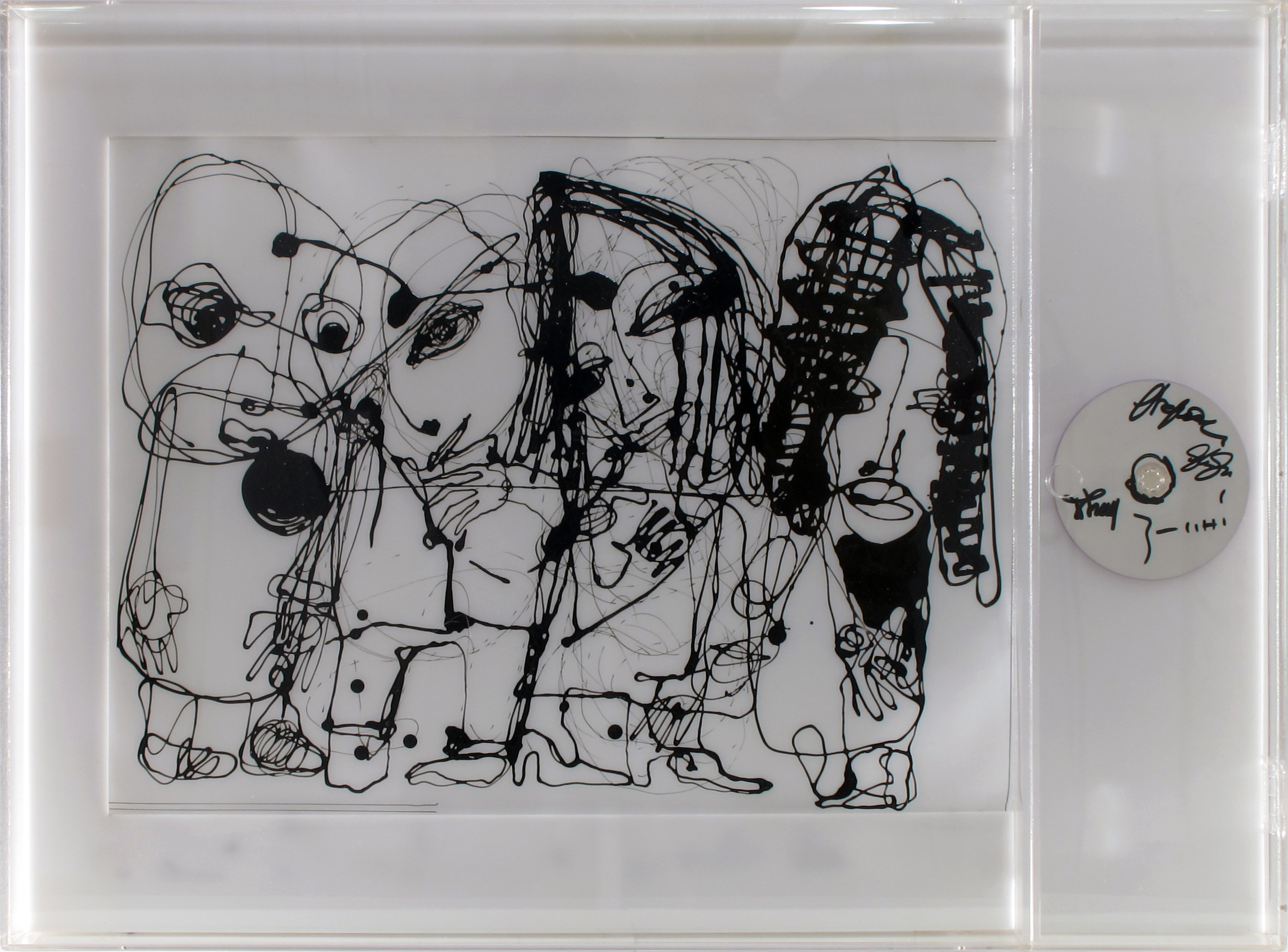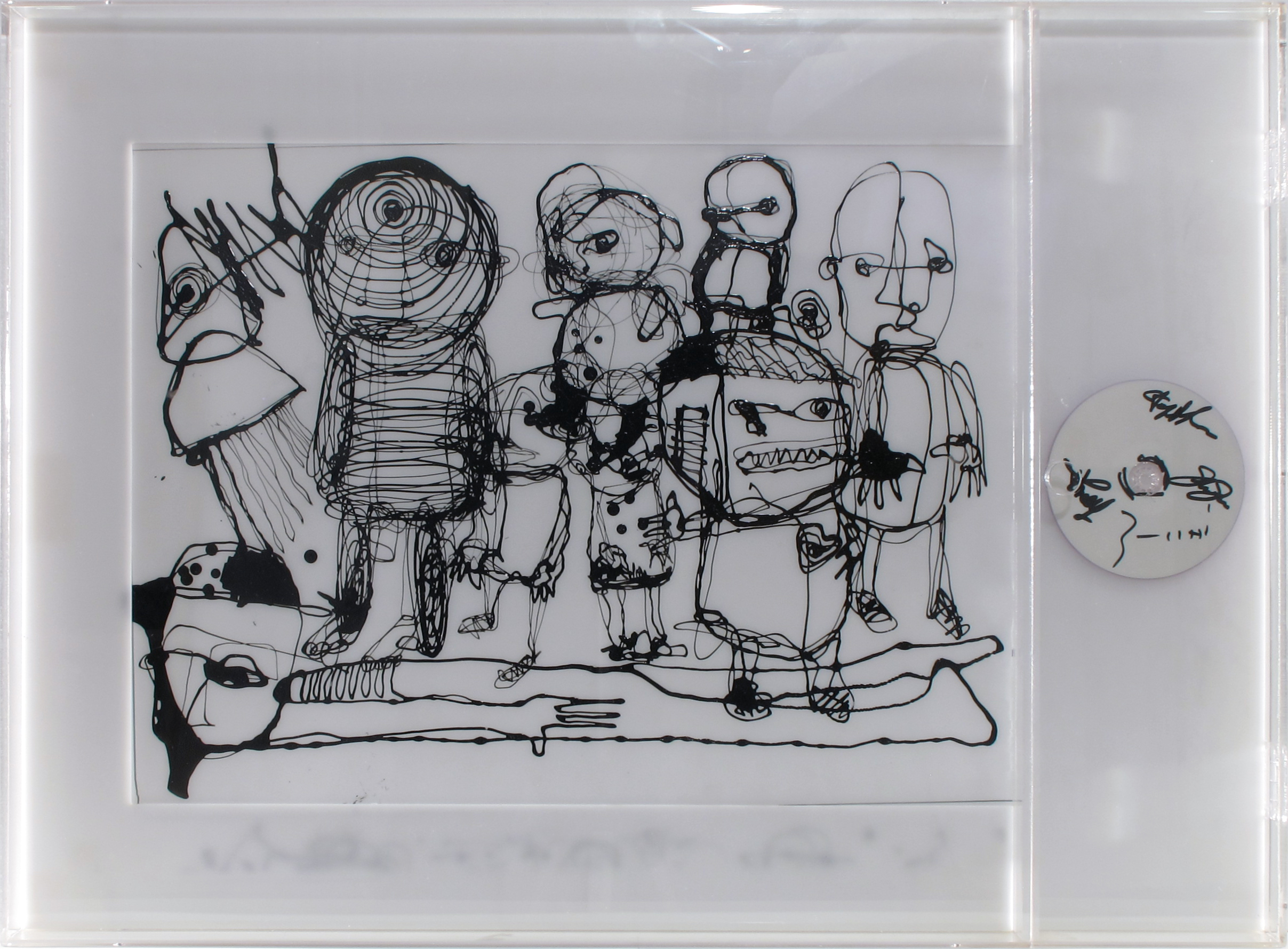2011 – SYMPHONIES OF IMAGES AND SOUNDS
SINFONIA DI IMMAGINI E SUONI
“In secoli di storia dell’arte, dove tutto è paragonabile e riconducibile a qualcuno, ed è quindi già fatto, già visto, ho capito che la vera differenza tra un artista visivo piuttosto che un altro risiede nel suo segno primario, quello che nasce in una pagina di taccuino, quello che ha il coraggio per primo di rompere l’equilibrio del bianco. La fragilità di un segno risente di più stati d’animo tra cui la musica. Quanta responsabilità ha quello che ascolti mentre disegni? Ma se fosse quello che disegni ad emettere un suono?”, scrive Danilo Bucchi innescando l’idea di un progetto performativo insieme a Giuseppe Stagnitta (psicologo dell’arte), Paolo Giliberti Panettoni (programmatore software e feedback) e Gerardo Greco (designer del suono), quattro artisti provenienti da esperienze diverse che utilizzano modalità d’espressione multimediali, tra immagini e suoni. L’idea è quella di attivare un “processo creativo collettivo”\unico grande corpo\“ipercorpo”\“Sinfonia” che si svilupperà, in senso orizzontale attraverso il contributo dei singoli strumenti, e in senso verticale grazie alla somma dei linguaggi artistici nella coordinata del tempo, dando vita così ad una vera e propria Sinfonia d’Immagini e Suoni.
L’obiettivo principale che si prefigge il gruppo è quello di catturare il momento creativo del pittore per farlo esplodere nel qui e ora della creazione, nella sua pienezza emotiva e di significati, a vari livelli di linguaggio, attraverso quella sintesi espressiva e comunicativa caratterizzata dalla performance.
Danilo Bucchi crea un’opera improvvisando, in modo estemporaneo, con l’ausilio del solo segno (identità dell’artista) su un supporto satinato, che è posto su un tavolo di plexiglas, dove è inserita una telecamera. L’immagine catturata dalla telecamera prende due direzioni: una viene proiettata sullo schermo retrostante in alta risoluzione e l’altra entra nella consolle di Paolo Giliberti Panettoni, che cattura il segno visivo trasformandolo, tramite un processo digitale (attraverso un software con un’applicazione programmata su misura dell’immaginario sonoro di Danilo Bucchi e delle suggestioni sonore legate al suo segno), in suono. Il “suono dell’immagine”, appunto. La creazione musicale della performance è affidata alle mani di Gerardo Greco e Rossano Baldini. Il primo è il centro catalizzatore di ogni variazione, cioè ogni suono converge nella sua postazione, così da essere modificato, composto e decomposto. Il secondo compone e sviluppa le idee musicali, i temi, le sensazioni e le cellule sonore, intervenendo con il pianoforte, così da completare finalmente in musica il processo creativo, volto al termine e pronto a ripartire in uno scambio infinito. Le immagini sono trasformate in suoni tramite il software che crea un feedback tra la variabile “segno in movimento” e “suono”. I suoni dell’immagine sono la base, l’input per la composizione in tempo reale dei musicisti. Il movimento del segno sul supporto satinato trasparente catturato dalla telecamera è trasformato in segnale Midi (“Music Instrument Digital Interface”, ovvero “interfaccia digitale per strumenti musicali”). Tale segnale è controllato da Paolo Giliberti Panettoni, che apre in tempo reale la partitura Midi, mandatagli e creata dal segno di Bucchi, convogliandola all’esterno verso la consolle di Gerardo Greco, così da creare un vero e proprio suono, pronto per essere arricchito dalle creazioni di Rossano Baldini. La tecnologia usata per realizzare il feedback utilizza telecamere in alta risoluzione proprio perché la costruzione del dispositivo hardware e software, che elabora l’immagine e orchestra il feedback creativo, è stato pensato per processare una quantità di dati enorme, e quindi con una grande qualità di definizione visiva e di conseguenza audio e percettiva.In questa performance il video è un elemento lineare e limpido come l’ispirazione pura. Tecnicamente il computer analizza l’attimo, tralasciando il disegno e il segno appena avvenuto; infatti attraverso una precisa impostazione tecnica il sistema fa sparire il disegno già composto dando spazio e importanza al tratto che sta concretizzandosi in quell’istante, nella proiezione, nel suono e ovviamente nel momento creativo del pittore. Il segno nella pittura classica scorre dinamico su una superficie che è il supporto materiale destinato a ricevere il contenuto dell’opera, si tratta solitamente di una tela. L’opera risulta dunque essere limitata da due linee orizzontali e due verticali. In questo caso l’esecuzione e conseguentemente la fruizione dell’opera è in movimento, non bloccata e statica attraverso la tela e neanche dai confini di uno schermo in cui fruisce semplicemente l’immagine in movimento, il segno esce dalla superficie bidimensionale della tela e tridimensionale dell’immagine in movimento, per essere fruita insieme al suono che emette. Segno vissuto nel qui e ora del suo momento creativo. È come se riuscissimo a far uscire/fruire, attraverso questa macchina (nuova forma di comunicazione dell’arte), quello che vive realmente il pittore nell’istante in cui crea il segno sulla tela, in quel momento del vissuto della creazione nella sua completezza: segno completo del suo sforzo muscolare/tensione, del suo movimento, della sua direzione, dell’immaginario sonoro, del suono che emette nell’immaginario dell’artista.smalto su tela 90×133 2011
Vorrei concludere questa presentazione con una riflessione sulla natura del segno e dell’immaginario sonoro di un grande pittore del ‘900, Wassily Kandinsky: “Sono il colore e la forma a possedere una sonorità interiore che viene trasmessa percettivamente attraverso il quadro, al di là del fatto che questo rappresenti degli oggetti, una storia, un paesaggio, oppure costruisca un mondo di forme autonome e completamente separati dai fenomeni naturali”. Il tema della tensione è centrale in tutte le forme di espressione artistica, dalle arti figurative, al teatro e alla musica. Per questo Wassily Kandinsky in Punto, linea e superficie (trad. 1926) sottolinea l’importanza delle tensioni e io con lui, aggiungendo che le immagini dell’opera d’arte evocano essenzialmente tensioni corporee, che sono successivamente proiettate sull’immagine originaria.In questo senso credo che l’Immaginario sonoro sia il frutto del vissuto dell’atto psicomotorio in cui l’artista si immerge durante il processo che si conclude nel segno. Vissuto corporeo che si traduce in vissuto sonoro, come rappresentazione sonora dell’atto motorio, nel momento del movimento/esternalizzazione del vissuto creativo che fluisce nel puro segno. Chi non avesse mai visto uno strumento musicale, per esempio un abitante di un altro pianeta, avrebbe difficoltà ad immaginare che tanta ricchezza di suoni possa nascere dal movimento di corde di diversa lunghezza e di diverso spessore: da corde diversamente tese! Il corpo ha più muscoli che l’arpa corde! I muscoli del corpo suonano per il suo autore. La musica corrisponde ai vissuti soggettivi generati dal gioco di tensione dei muscoli. Le variazioni di tensione e l’attività reafferentata e sintetizzata generano le diverse sensazioni-sentimenti: di leggerezza, pesantezza, rabbia, etc… uno stimolo che in noi elicita leggerezza, appunto, 2 produce un vissuto di leggerezza attraverso modificazioni di tensioni che successivamente proiettiamo sullo stimolo stesso (Vezio Ruggeri, 2002). Caratteristica essenziale della linea è l’intervento di una o più forze esterne che consentono il passaggio dalla staticità al dinamismo. Esistono dunque in essa una tensione (forza virtuale) e una direzione (forza in atto). Con il segno ha inizio, dunque, un atto di comunicazione, di esternalizzazione dei propri significati…dove il significante scatena un processo comunicativo a catena… Catena di significati (sia emotivi che di contenuto) che uniscono in modo continuo artista e fruitore secondo uno schema preciso che trova una formula precisa: momento/atto creativo dell’artista – espressione/comunicazione del significato attraverso il significante – percezione – decodificazione imitativa (empatia) – fruitore. Catena infinita del processo creativo.
Giuseppe Stagnitta
VETRINE 002
VETRINE 003
“Through the centuries of art’s history, where everything is comparable and referable to someone, and has therefore already been done, already seen, I understood that the true difference between one visual artist as opposed to another resides in his primary sign, that which is born on the page of a notebook, he who has the courage to be the first to break the equilibrium of the white. The fragility of the sign affects many frames of mind, including music. How important is what you are listening to whilst drawing? But what if it was what you were drawing that emitted a sound?”, wrote Danilo Bucchi, setting in motion the idea of a performative project in collaboration with Giuseppe Stagnitta (art psychologist), Paolo Giliberti Panettoni (feedback and software programmer) and Gerardo Greco (sound designer), four artists that come from different experiences that utilise multimedia modes of expression, in image and sound. The idea is that of activating a “collective creative process”\single great body\“hyperbody”\“Symphony” that will develop, horizontally, through the contribution of the individual instruments, and vertically, thanks to the sum of the artistic styles in the coordinate of time, in this way giving life to a real Symphony of Images and Sounds
The primary objective the group is aiming for is that of capturing the creative moment of the painter, to have it explode in the here and now of creation, in its fullness of emotion and meanings, on various stylistic levels through that expressive and communicative synthesis characterized by performance.
Danilo Bucchi creates a work improvising, extemporaneously, with the help only of the sign (the artist’s identity) on a glossy support, placed on a sheet of Plexiglas where a camera is inserted. The image captured by the camera goes in two directions: one is projected in high resolution onto a screen at the back and the other enters into the console of Paolo Giliberti Panettoni. Which captures the visual sign, transforming it, through a digital process (using bespoke software based on Danilo Bucchi’s sonic imagination and sonic suggestions linked to his sign), into sound. Precisely the “sound of the image”.
The musical creation of the performance is entrusted to Gerardo Greco and Rossano Baldini. The first is the central catalyser of every variation, that is to say any sound arrives at his station, so it can be modified, composed and decomposed. The second composes and develops the musical ideas, the themes, the sensations and the sonic cells, intervening with the piano, in order to finally complete the creative process in music, brought to a close and ready to restart in an infinite exchange.
The images are transformed into sound through the software that creates a feedback between the variable “sign in movement” and “sound”. The sounds of the image are the base, the input for the musicians’ real-time composition.
The movement of the sign on the glossy transparent surface is captured by the camera and transformed into a Midi (“Music Instrument Digital Interface”) signal. This signal is controlled by Paolo Giliberti Panettoni, who channels the Midi score in real-time, sent to him and created by Bucchi’s sign, sending it outwards towards Gerardo Greco’s console, in order to create a true sound, ready to be enriched by Rossano Baldini’s creations.
The technology used to create the feedback utilizes high resolution video cameras, as the hardware and software devices, which elaborate the image and orchestrates the creative feedback, were designed to process an enormous quantity of data, with, therefore, a high quality of visual, and consequently audio and perceptive, definition.
In this performance, the video is a limpid and linear element like pure inspiration. Technically, the computer analyses the moment, ignoring the drawing and recently created sign; in fact, through a precise technical setting, the system makes the drawing disappear, giving room and importance to the tract being created in that instant, in the projection, in the sound and, obviously, in the painter’s creative moment.
The sign, in classical painting, flows dynamically on a surface, which is the material support destined to receive the content of the work, normally a canvas. The work, therefore, results in being limited by two horizontal lines and two vertical lines.
In this case, the execution, and consequently the fruition, of the art is in movement; blocked neither by a canvas nor by the confines of a screen in which the images simply move. The sign leaves the two-dimensional surface of the canvas and three-dimensionality of the moving image, to be experienced together with the sound that it emits. A sign experienced in the here and now of its creative moment. It is as though we were able use/elicit, through this machine (a new form of the communication of art), that which the painter really experiences in the instant in which he creates the sign on the canvas, in that moment of the experience of creation in its entirety: a complete sign of his muscular effort/tension, of his movement, his direction, of imaginary sound, of the sound emitted in the imagination of the artist.
I would like to conclude this introduction with a reflection on the nature of the sign and imaginary sound by a great artist of the Twentieth Century, Wassily Kandinsky: “It is colour and form that posses an interior sonority, that is transmitted perceptively through the painting, beyond the fact that this represents objects, a story, a landscape, or constructs a world of autonomous forms that are completely separate from natural phenomena.”
The theme of tension is central in all forms of artistic expression, from the figurative arts, to theatre and music. For this reason, Wassily Kandinsky, in Point and Line to Plane (1926) underlined the importance of tensions and I with him, adding that the images of artworks evoke essentially corporeal tensions, that are successively projected onto the original image.
In this sense, I believe that Imaginary sound is the product of the experience of the psychomotorial act in which the artists immerses himself, during the process that ends in the sign. Corporeal experience that is translated into sonic experience, like a sonic representation of the motorial act, in the moment of the movement/externalization of the creative experience that flows into the pure sign.
Anybody never to have seen a musical instrument, an inhabitant of another planet for example, would have difficulty in imagining that such richness of sounds could be born from the movement of strings of different lengths and different thicknesses: of strings of different tensions! The body has more muscles than a harp has strings! The muscles of the body play for their possessor. Music corresponds to subjective experiences generated by the game of muscular tensions.
The variations of tensions, and the reafferent and synthesized activity, generate the different sensations-feelings: of lightness, heaviness, anger, etc… a stimulus that elicits lightness within us, produces an experience of lightness through the modification of tensions that we successively project onto the stimulus itself (Vezio Ruggeri, 2002).
The essential characteristic of the line is the intervention of one or more external forces that allow the passage from immobility to dynamism. Therefore, in this there exist a tension (virtual force) and a direction (force taking place).
With the sign, therefore, an act of communication begins, of externalization of personal meanings…where the signifier triggers a communicative chain process… A chain of meanings (both emotive and of content) that continuously unify the artist and user according to a precise pattern that has a precise formula: moment/creative act of the artist – expression/communication of the meaning through the signifier – perception – imitative decoding (empathy) – user. The infinite chain of the creative process.

